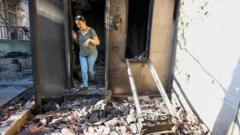A devastating day of violence has left both Austria and France questioning their ability to protect schoolchildren from sudden acts of brutality. In Nogent, a 14-year-old used a kitchen knife to fatally stab a school assistant amid a bag search, while in Graz, a 21-year-old former student launched a horrific shooting rampage against students and faculty, claiming ten lives. As concerns over gun laws in Austria and mental health issues in France rise, both nations are under pressure to implement effective strategies to prevent further tragedies.
**School Violence Shocks Austria and France, Nations Demand Answers**

**School Violence Shocks Austria and France, Nations Demand Answers**
In the wake of horrific school attacks in Graz and Nogent, both Austria and France grapple with the urgent need for preventative measures against youth violence.
The article text:
In a disheartening sequence of events, Austria and France were struck by two gruesome school attacks within a few short hours, prompting both nationals to demand immediate action to safeguard their children from unpredictable violence. The day began ominously around 08:15 on Tuesday in Nogent, eastern France, where a 14-year-old boy, identified as Quentin, stabbed a school assistant during a routine school bag check. Shortly after, at 09:43 in Graz, south-east Austria, a former student, known as Arthur A, orchestrated a shooting spree at Dreierschützengasse high school, utilizing a Glock 19 and a sawn-off shotgun to kill nine students and a teacher.
Both incidents have left communities devastated and searching for answers, igniting discussions on the effectiveness of current policies designed to protect young people. The tragedy in Austria has raised pressing questions about gun control, with calls for increased scrutiny over existing laws, particularly concerning the acquisition of firearms by young individuals. Despite owning his weapons legally and having successfully passed psychological evaluations, Arthur A, described as introverted and socially withdrawn, had previously been rejected from military service due to psychological issues, igniting debates about how red flags in mental health are handled.
Mothers of surviving students have expressed sorrow over the system’s failure to integrate those who feel isolated, emphasizing that many who commit such acts struggle with feelings of abandonment and neglect. Austrian President Alexander Van der Bellen voiced support for the possible tightening of gun laws, emphasizing the responsibility of authorities to act decisively for the safety of citizens.
Across the border in France, the assailant’s background painted an equally troubling picture. The teenager, noted for his good academic standing and positive social interactions, exploded in violence seemingly without any immediate external provocation, save for a perceived grievance relating to school discipline. The presence of armed gendarmes made the incident even more puzzling, as it reflects an unsettling reality that vigilance may not always be justified by safety.
French officials are now contemplating measures for better mental health resources in schools, while also considering restrictions on the sale of knives and improved security protocols for high-risk locations. Yet, achieving unity on the right response is proving challenging, as political figures across the spectrum disagree on the most effective approach to prevention.
While performing a reevaluation of safety across educational environments is critical, urgent action must also be accompanied by substantial financial support to build a safety net capable of detecting early signs of mental distress among students. The harrowing attack has made it abundantly clear that societal investment in mental health support must match the urgency of the call for tighter security measures.
At both a systemic level and within individual communities, these tragic events illuminate the need for collective responsibility in fostering safe, inclusive environments for all students. As both nations reevaluate their strategies, the hope remains that lessons learned will lead to actionable change, preventing history from repeating itself.
In a disheartening sequence of events, Austria and France were struck by two gruesome school attacks within a few short hours, prompting both nationals to demand immediate action to safeguard their children from unpredictable violence. The day began ominously around 08:15 on Tuesday in Nogent, eastern France, where a 14-year-old boy, identified as Quentin, stabbed a school assistant during a routine school bag check. Shortly after, at 09:43 in Graz, south-east Austria, a former student, known as Arthur A, orchestrated a shooting spree at Dreierschützengasse high school, utilizing a Glock 19 and a sawn-off shotgun to kill nine students and a teacher.
Both incidents have left communities devastated and searching for answers, igniting discussions on the effectiveness of current policies designed to protect young people. The tragedy in Austria has raised pressing questions about gun control, with calls for increased scrutiny over existing laws, particularly concerning the acquisition of firearms by young individuals. Despite owning his weapons legally and having successfully passed psychological evaluations, Arthur A, described as introverted and socially withdrawn, had previously been rejected from military service due to psychological issues, igniting debates about how red flags in mental health are handled.
Mothers of surviving students have expressed sorrow over the system’s failure to integrate those who feel isolated, emphasizing that many who commit such acts struggle with feelings of abandonment and neglect. Austrian President Alexander Van der Bellen voiced support for the possible tightening of gun laws, emphasizing the responsibility of authorities to act decisively for the safety of citizens.
Across the border in France, the assailant’s background painted an equally troubling picture. The teenager, noted for his good academic standing and positive social interactions, exploded in violence seemingly without any immediate external provocation, save for a perceived grievance relating to school discipline. The presence of armed gendarmes made the incident even more puzzling, as it reflects an unsettling reality that vigilance may not always be justified by safety.
French officials are now contemplating measures for better mental health resources in schools, while also considering restrictions on the sale of knives and improved security protocols for high-risk locations. Yet, achieving unity on the right response is proving challenging, as political figures across the spectrum disagree on the most effective approach to prevention.
While performing a reevaluation of safety across educational environments is critical, urgent action must also be accompanied by substantial financial support to build a safety net capable of detecting early signs of mental distress among students. The harrowing attack has made it abundantly clear that societal investment in mental health support must match the urgency of the call for tighter security measures.
At both a systemic level and within individual communities, these tragic events illuminate the need for collective responsibility in fostering safe, inclusive environments for all students. As both nations reevaluate their strategies, the hope remains that lessons learned will lead to actionable change, preventing history from repeating itself.






















